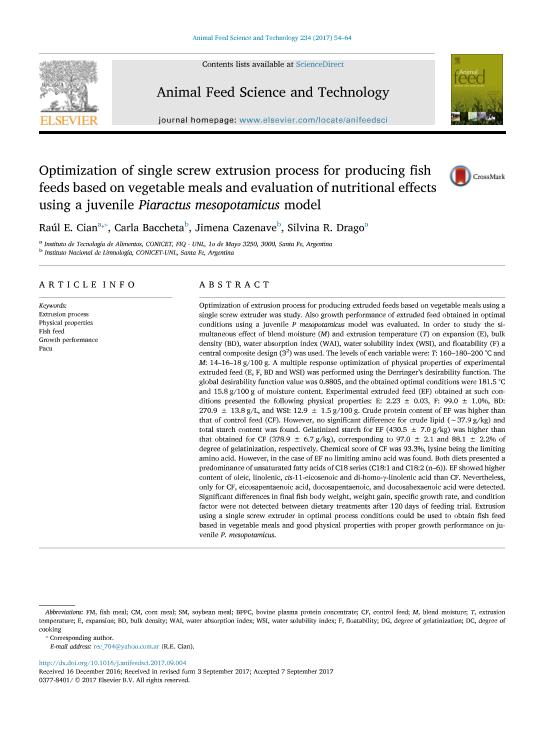Mostrar el registro sencillo del ítem
dc.contributor.author
Cian, Raúl Esteban

dc.contributor.author
Bacchetta, Carla

dc.contributor.author
Cazenave, Jimena

dc.contributor.author
Drago, Silvina Rosa

dc.date.available
2018-09-07T13:58:21Z
dc.date.issued
2017-12
dc.identifier.citation
Cian, Raúl Esteban; Bacchetta, Carla; Cazenave, Jimena; Drago, Silvina Rosa; Optimization of single screw extrusion process for producing fish feeds based on vegetable meals and evaluation of nutritional effects using a juvenile Piaractus mesopotamicus model; Elsevier Science; Animal Feed Science and Technology; 234; 12-2017; 54-64
dc.identifier.issn
0377-8401
dc.identifier.uri
http://hdl.handle.net/11336/58678
dc.description.abstract
Optimization of extrusion process for producing extruded feeds based on vegetable meals using a single screw extruder was study. Also growth performance of extruded feed obtained in optimal conditions using a juvenile P mesopotamicus model was evaluated. In order to study the simultaneous effect of blend moisture (M) and extrusion temperature (T) on expansion (E), bulk density (BD), water absorption index (WAI), water solubility index (WSI), and floatability (F) a central composite design (32) was used. The levels of each variable were: T: 160–180–200 °C and M: 14–16–18 g/100 g. A multiple response optimization of physical properties of experimental extruded feed (E, F, BD and WSI) was performed using the Derringer's desirability function. The global desirability function value was 0.8805, and the obtained optimal conditions were 181.5 °C and 15.8 g/100 g of moisture content. Experimental extruded feed (EF) obtained at such conditions presented the following physical properties: E: 2.23 ± 0.03, F: 99.0 ± 1.0%, BD: 270.9 ± 13.8 g/L, and WSI: 12.9 ± 1.5 g/100 g. Crude protein content of EF was higher than that of control feed (CF). However, no significant difference for crude lipid (∼37.9 g/kg) and total starch content was found. Gelatinized starch for EF (430.5 ± 7.0 g/kg) was higher than that obtained for CF (378.9 ± 6.7 g/kg), corresponding to 97.0 ± 2.1 and 88.1 ± 2.2% of degree of gelatinization, respectively. Chemical score of CF was 93.3%, lysine being the limiting amino acid. However, in the case of EF no limiting amino acid was found. Both diets presented a predominance of unsaturated fatty acids of C18 series (C18:1 and C18:2 (n–6)). EF showed higher content of oleic, linolenic, cis-11-eicosenoic and di-homo-γ-linolenic acid than CF. Nevertheless, only for CF, eicosapentaenoic acid, docosapentaenoic, and docosahexaenoic acid were detected. Significant differences in final fish body weight, weight gain, specific growth rate, and condition factor were not detected between dietary treatments after 120 days of feeding trial. Extrusion using a single screw extruder in optimal process conditions could be used to obtain fish feed based in vegetable meals and good physical properties with proper growth performance on juvenile P. mesopotamicus.
dc.format
application/pdf
dc.language.iso
eng
dc.publisher
Elsevier Science

dc.rights
info:eu-repo/semantics/openAccess
dc.rights.uri
https://creativecommons.org/licenses/by-nc-sa/2.5/ar/
dc.subject
Extrusion Process
dc.subject
Fish Feed
dc.subject
Growth Performance
dc.subject
Pacu
dc.subject
Physical Properties
dc.subject.classification
Alimentos y Bebidas

dc.subject.classification
Otras Ingenierías y Tecnologías

dc.subject.classification
INGENIERÍAS Y TECNOLOGÍAS

dc.title
Optimization of single screw extrusion process for producing fish feeds based on vegetable meals and evaluation of nutritional effects using a juvenile Piaractus mesopotamicus model
dc.type
info:eu-repo/semantics/article
dc.type
info:ar-repo/semantics/artículo
dc.type
info:eu-repo/semantics/publishedVersion
dc.date.updated
2018-09-06T18:44:01Z
dc.journal.volume
234
dc.journal.pagination
54-64
dc.journal.pais
Países Bajos

dc.journal.ciudad
Amsterdam
dc.description.fil
Fil: Cian, Raúl Esteban. Consejo Nacional de Investigaciones Científicas y Técnicas; Argentina. Universidad Nacional del Litoral. Facultad de Ingeniería Química. Instituto de Tecnología de los Alimentos; Argentina
dc.description.fil
Fil: Bacchetta, Carla. Consejo Nacional de Investigaciones Científicas y Técnicas. Centro Científico Tecnológico Conicet - Santa Fe. Instituto Nacional de Limnología. Universidad Nacional del Litoral. Instituto Nacional de Limnología; Argentina
dc.description.fil
Fil: Cazenave, Jimena. Consejo Nacional de Investigaciones Científicas y Técnicas. Centro Científico Tecnológico Conicet - Santa Fe. Instituto Nacional de Limnología. Universidad Nacional del Litoral. Instituto Nacional de Limnología; Argentina
dc.description.fil
Fil: Drago, Silvina Rosa. Consejo Nacional de Investigaciones Científicas y Técnicas; Argentina. Universidad Nacional del Litoral. Facultad de Ingeniería Química. Instituto de Tecnología de los Alimentos; Argentina
dc.journal.title
Animal Feed Science and Technology

dc.relation.alternativeid
info:eu-repo/semantics/altIdentifier/doi/https://dx.doi.org/10.1016/j.anifeedsci.2017.09.004
dc.relation.alternativeid
info:eu-repo/semantics/altIdentifier/url/https://www.sciencedirect.com/science/article/pii/S0377840116311452
Archivos asociados
